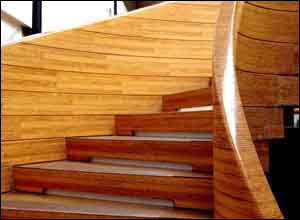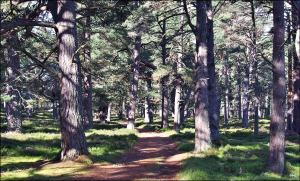How do trees work for us?
(if we look after them well)
"Trees of the People" 13 chapters, to download separately.
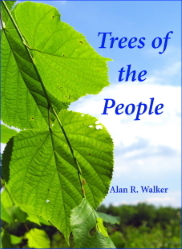
Trees are important to people for fuel, shelter, timber, recreation and to store carbon away from our atmosphere. This book provides accessible information about how trees and woodlands work and how we work with them. It is presented as reporting on the current state of knowledge about how trees and forests work and how they are used. This information is from current research papers, recent textbooks, conversations with foresters and botanists, and my own observations during field visits. Full lists of references are provided and the chapters are updated regularly.
History of forests
How they migrated to survive ice-ages
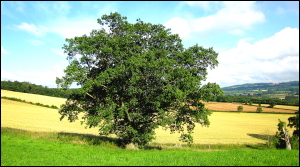
Oak tree isolated in farmland. Long ago this region had large forests dominated by oaks.
Forests work on a timescale measured in centuries and more. They can adapt to changes in their climate that operate at the scale of ice-ages and they do this mostly by migrating to regions where they can reproduce better.
Download HISTORY (2Mb)
Reproduction by trees
From cones to seeds to new trees
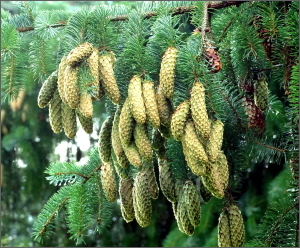
Female cones of a Sitka spruce tree ripening in mid-summer.
Trees use huge material resources each year to produce enormous numbers of seeds but few become the next generation of mature trees. Mechanisms of reproduction by both conifers and flowering trees are complex but can be observed in the structures of cones and flowers as they develop.
Download REPRODUCTION (2Mb)
Photosynthesis by trees
Energy of sunlight harvested as wood
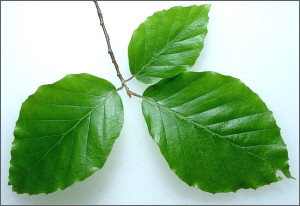
Leaves of beech, a tree of great value as timber and aesthetically.
Life on Earth is powered by sunlight and trees predominate in capturing this energy. Trees use this energy to incorporate carbon from the atmosphere to synthesize organic matter, mainly as wood. This chapter describes pathways of energy and matter from green leaves through to harvested timber.
Download PHOTOSYNTHESIS (3Mb)
Leaf-fall by trees
When should leaves fall and how do they fall?
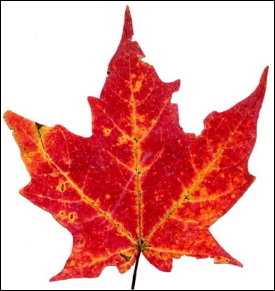
Maple tree deciduous leaf during fall after the green photosynthetic pigments have been withdrawn by the tree.
How do some deciduous broad-leaf tree species manage to flourish in regions that seem suitable only for coniferous needle-leaf species? Why do some needle-leaf conifers shed all their leaves before the onset of every winter? Answers are found in recent studies showing how all types of leaves are adapted for optimal gain of energy and materials under varying physical and biological constraints upon photosynthesis.
Download LEAF-FALL (4Mb)
Tree roots and mycorrhizas
Root functions and their fungal partners
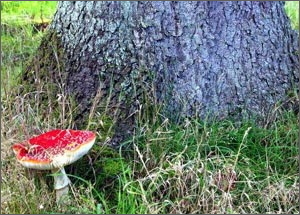
Larch tree with a fly-agaric mushroom. This fungus works with tree roots in a mycorrhizal relationship.
Roots are as essential to trees as the leaves are. They seek nutrients in the soil by constant regrowth. Nutrients are lifted up to the leaves by a process of suction within the leaves called transpiration. Tree roots often work in a combination with fungi that is mutually beneficial to both tree and fungus by providing nutrients to the tree in exchange for sugars from the tree. These types of fungi are called mycorrhizas. The relationships are complex and difficult to study under field conditions of a forest. This has led to controversies of understanding how trees benefit from mycorrhizal fungi. This chapter provides a perspective on this controversy based on what is can be seen in a standing forest and in the light of what is known about the evolutionary constraints on both trees and fungi.
Download ROOTS (2Mb)
Carbon storage by trees
Growing trees to remove carbon dioxide from the air
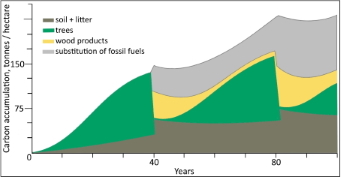
Accumulating carbon storage in a conifer plantation over 80 years, with harvesting every 40 years.
Plants grow by transforming the carbon of carbon dioxide gas in the atmosphere into the structures of their bodies. Trees store huge amounts of carbon for decades to centuries. Tree planting is now promoted worldwide as an important contribution to mitigating the climate crisis.
Download CARBON (2Mb)
Wooden buildings
Using trees instead of concrete and steel
A spiral staircase made with types of engineered wood.
There is a growing trend of using wood as the main structural material for houses, apartment blocks and offices. Wood can be stronger and more flexible than reinforced concrete, and simpler to assemble on site as a new building. Another advantage is to store carbon within the structure of the building.
Download BUILDINGS (2Mb)
Trees for fuel
From cooking to generating electricity
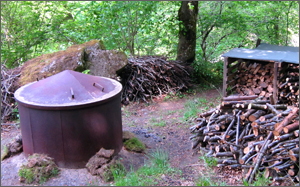
Kiln for small-scale production of charcoal.
Crucial stages in the development of human society were the inventions of how to use fire, and cooking our food. Harvesting of woody fuel became essential, and when we invented manufacture of charcoal our ability to produce metal tools and ceramics followed. Fuelwood continues to be essential for many people in many regions of the world.
Download FUELWOOD (2Mb)
Woodland regeneration
Creating and regenerating natural woodlands
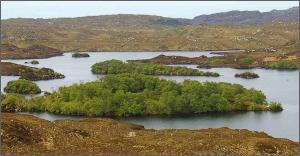
Natural growth of trees on an island gives information on what to plant in a regeneration project.
Regeneration of woodland is increasingly popular. This chapter ranges from community projects to restore areas of disused land to a former wooded character, through to silvicultural methods to protect seedlings and establish a self-generating wood.
Download REGENERATION (2Mb)
Forest migrations
How did this pine forest arrive here?
Stand of Scots pines in a national park, growing as part of the original vast forest.
Scots pine probably originated as a new, separate, species somewhere central to eastern Europe. From there it spread and established a vast forest reaching across from the seaboards of the Atlantic and Pacific Oceans. The ecological processes, constraints, and adaptations that enabled this migration is the theme of this chapter.
Download PINE FOREST (2Mb)
Herbivore animals as pests of forests
Spruce budworm moths and moose in conifer forests
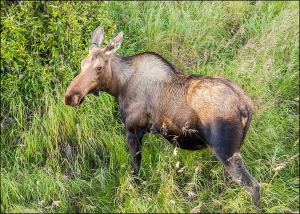
Moose inhabit forests of North America and Eurasia. (Photo credit: Diego Delso, Wikimedia)
Two examples here of animals that affect ecology of forests and become pests in production forestry. An insect of forests of North America, the caterpillars of spruce budworm moth, is described. Moose feed on leaves of conifers during winter. They live in North America and Scandinavia and are studied in relation to ecology and management of timber forests.
Download HERBIVORE (2Mb)
Deforestation, then reforestation
How forest transitions come about

Felling trees leaves an ugly mess and deforestation looks alarming but deforestation needs to be balanced against need for farm-land. As farming becomes more efficient there is less need for low intensity livestock pastures and here regeneration happens.
This chapter discusses the trend identified by some foresters and botanists of a historical process of extensive felling of trees for timber and to clear land for food crops, gradually followed by intensification or displacement of agriculture, leading eventually to regeneration of forests. This chapter is also closely related to the article on this website about forest growth, in the section Arguments, title: "Are the world's forests really expanding?"
Download DEFORESTATION (2Mb)
Myths and cultures of the forest
Stories, art, artifacts and ideas of people about trees and forests

A bench for people to use whilst visiting a woodland park represents one aspect of people's mythology and culture of woods and forests. Here a dragon is part of this woodcarving: some fearsome creature of the forest, or just a playful display of wood-work skill?
This chapter is different in style from all the other 12 chapters about trees. Many illustrations are used to provide detailed information. It covers mythical creatures of the forests, both fearsome and benign. Styles of art and the difficulty of representing trees as artwork on paper are discussed. The traditions of providing sustainable use of forest resources are shown to derive from cultures of forest resource management. The difficulty of providing accessible information about how trees and forests work, through the use of metaphor, is covered as the final part of this varied chapter.
Download Myths (2Mb)

